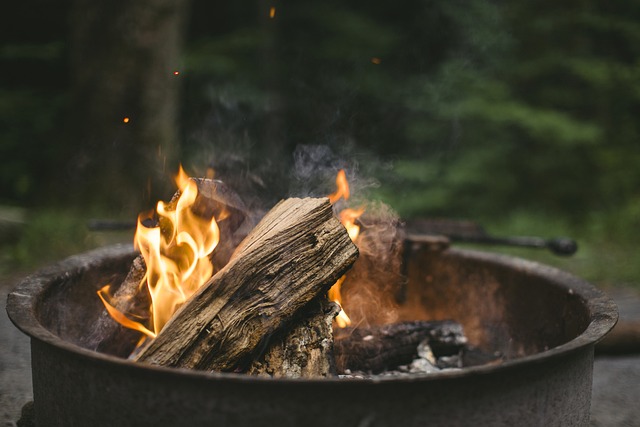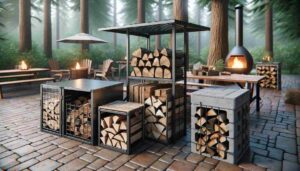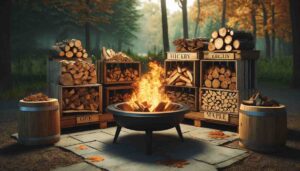Firewood has been a vital source of heat and energy for centuries, serving as the lifeblood of countless households during the cold winter months. When it comes to choosing firewood, not all woods are created equal. Some varieties burn hotter, longer, and cleaner than others. Among these exceptional options is black locust firewood, prized for its impressive BTU (British Thermal Units) output and overall quality. In this comprehensive guide, we will explore everything you need to know about black locust firewood, from buying and burning to its attributes and benefits.
Understanding Black Locust (Robinia pseudoacacia)
Before delving into the specifics of black locust firewood, it’s essential to understand the tree from which it is sourced. Black locust, scientifically known as Robinia pseudoacacia, is a deciduous tree native to North America. It is also commonly referred to as false acacia or honey locust, though it is distinct from true acacia species.
Characteristics of Black Locust Trees
- Appearance: Black locust trees are typically medium-sized, growing up to 80 feet in height. They have a distinctive compound leaf structure, with small leaflets and fragrant white flowers that bloom in spring.
- Hardiness: Black locust is known for its hardiness and adaptability. It can thrive in various soil types and is well-suited to a range of climates.
- Wood Quality: The wood of black locust is exceptionally durable and resistant to decay, making it highly sought after for a variety of applications, including fence posts, outdoor furniture, and, of course, firewood.
Black Locust Firewood Attributes
One of the primary reasons why black locust firewood is favored by many is its remarkable set of attributes that make it stand out among other firewood options:
1. High BTU Content
BTU, or British Thermal Units, is a measurement of heat energy. When it comes to firewood, higher BTU content translates to more heat output when burned. Black locust is renowned for its exceptional BTU rating, making it one of the hottest-burning firewood choices available. It typically ranges from 26 to 32 million BTUs per cord, depending on the wood’s moisture content and other factors.
2. Long Burn Time
Not only does black locust produce intense heat, but it also burns slowly and steadily. This means you can enjoy a longer-lasting fire and less frequent reloading of your wood-burning stove or fireplace when using black locust firewood.
3. Low Smoke and Sparks
Black locust firewood is known for producing minimal smoke and sparks compared to some other hardwoods. This makes it a cleaner and safer option for indoor and outdoor fires.
4. High Density
The density of wood affects its overall burn quality. Black locust wood is dense, which contributes to its impressive heat output and slow burn rate. This density also means that you’ll need less wood to achieve the same level of warmth compared to less dense varieties.
5. Resistance to Decay and Insects
Black locust is naturally resistant to decay and insects, thanks to its high tannin content. This characteristic makes it an excellent choice for outdoor applications like fence posts and helps it withstand the elements when used as firewood.
Buying Black Locust Firewood
Now that you’re aware of the outstanding qualities of black locust firewood, you might be eager to find a reliable source. Here are some tips for buying black locust firewood:
1. Local Suppliers
Start your search by looking for local firewood suppliers who offer black locust. Local sources are often more sustainable and environmentally friendly because they reduce transportation emissions. You can search online, ask for recommendations from neighbors or friends, or check classified ads for firewood listings.
2. Ask About Moisture Content
When purchasing firewood, it’s crucial to inquire about its moisture content. Wood with high moisture content can be challenging to burn efficiently. The ideal moisture content for firewood is typically around 20% or lower. Well-seasoned black locust firewood should meet this requirement.
3. Buy in Cord Measurements
Firewood is typically sold by the cord, which is a standard unit of measurement. A cord of firewood is a stack that measures 4 feet high, 4 feet wide, and 8 feet long, equaling 128 cubic feet. Buying in cord measurements ensures you receive a consistent and fair amount of firewood for your money.
4. Inspect the Wood
Before finalizing your purchase, inspect the wood to ensure it is of good quality. Look for signs of decay, insect damage, or excessive splitting. High-quality black locust firewood should be clean, well-seasoned, and free from defects.
5. Price Comparison
While black locust firewood is considered a premium choice, prices can vary depending on your location and the supplier. It’s a good idea to obtain quotes from multiple suppliers and compare prices to ensure you’re getting a reasonable deal.
Burning Black Locust Firewood
Once you’ve acquired your black locust firewood, it’s time to start enjoying the benefits of this exceptional wood. Here are some tips for burning black locust firewood efficiently and safely:
1. Properly Season the Wood
Seasoning firewood is the process of allowing it to dry out to achieve an optimal moisture content. Freshly cut wood can contain a high percentage of moisture, which can lead to inefficient burning and excessive creosote buildup in your chimney. To season black locust firewood, store it in a dry, well-ventilated area for at least six months to a year.
2. Use a Moisture Meter
Invest in a moisture meter to accurately measure the moisture content of your firewood. This tool will help you ensure that your wood is adequately seasoned and ready for burning. Aim for a moisture content of 20% or lower for optimal performance.
3. Store Firewood Properly
Proper firewood storage is essential to maintain its quality. Stack your firewood off the ground on pallets or a rack to prevent moisture absorption from the soil. Cover the top of the stack to shield it from rain and snow while allowing for proper airflow to continue the seasoning process.
4. Build a Good Fire
When lighting your fire, start with kindling and gradually add larger pieces of black locust firewood as the fire grows. Properly stacking the wood to create a good draft will help maintain steady combustion and reduce smoke.
5. Maintain Your Fireplace or Wood-Burning Stove
Regular maintenance of your heating appliance is crucial for safety and efficiency. Clean the chimney or flue as needed to prevent creosote buildup, which can lead to chimney fires. Follow manufacturer guidelines for maintenance and operation.
6. Safety Precautions
Always follow safety precautions when using black locust firewood or any other type of firewood. Use a screen or glass door on your fireplace to prevent sparks from escaping, and have a fire extinguisher nearby. Additionally, ensure you have working carbon monoxide detectors in your home.
Comparing Black Locust to Other Firewood Types
To fully appreciate the benefits of black locust firewood, it’s helpful to compare it to other common firewood types in terms of BTU content and burn characteristics. Here’s a quick overview of how black locust stacks up against some popular options:
Black Locust vs. Oak
Oak is a well-known hardwood prized for its durability and heat output. While oak is an excellent firewood choice, black locust often surpasses it in terms of BTU content. Black locust’s high density allows it to burn hotter and longer than many oak varieties.
Black Locust vs. Maple
Maple is another hardwood commonly used for firewood. While maple produces good heat and is readily available, black locust tends to burn hotter and more efficiently. This makes black locust a preferred option for those seeking maximum heat output.
Black Locust vs. Pine
Pine is a softwood that is often less dense than hardwoods like black locust. While pine can be suitable for kindling and starting fires, it tends to burn faster and produce less heat compared to black locust. Black locust is a better choice for sustaining a long, warm fire.
Black Locust vs. Cherry
Cherry wood is known for its pleasant aroma when burned, but it generally has a lower BTU rating compared to black locust. Black locust provides a higher heat output, making it a better choice for heating purposes.
The Environmental Aspect
Sustainability and environmental impact are important considerations when using firewood as a heating source. Black locust has several environmental advantages:
1. Rapid Growth
Black locust is known for its rapid growth, which makes it a renewable resource. When managed responsibly, black locust forests can provide a continuous supply of wood without depleting the ecosystem.
2. Minimal Chemical Treatment
Due to its natural resistance to insects and decay, black locust requires minimal chemical treatment, reducing the environmental impact associated with some other wood types.
3. Carbon Neutrality
When burned, black locust releases carbon dioxide (CO2) into the atmosphere, but this is part of the natural carbon cycle. As long as new trees are planted to replace those harvested for firewood, the carbon emissions can be considered carbon-neutral.
Conclusion
Black locust firewood is an excellent choice for those seeking a high-quality, efficient, and sustainable heating source. With its exceptional BTU content, long burn time, low smoke and sparks, and resistance to decay, black locust stands out as a premium firewood option. By following proper guidelines for buying, seasoning, and burning black locust firewood, you can enjoy a warm and cozy home while minimizing environmental impact.
Before purchasing black locust firewood, it’s essential to do your research, find reputable suppliers, and ensure the wood is properly seasoned. Additionally, practicing safety precautions and proper maintenance of your heating appliance are vital for a safe and efficient wood-burning experience.
As you enjoy the warmth and comfort provided by your black locust firewood, you can also take satisfaction in the knowledge that you are using a renewable and environmentally friendly heat source. So, whether you’re heating your home, cooking, or simply enjoying a crackling fire, black locust firewood is an excellent choice that combines performance, sustainability, and reliability.










